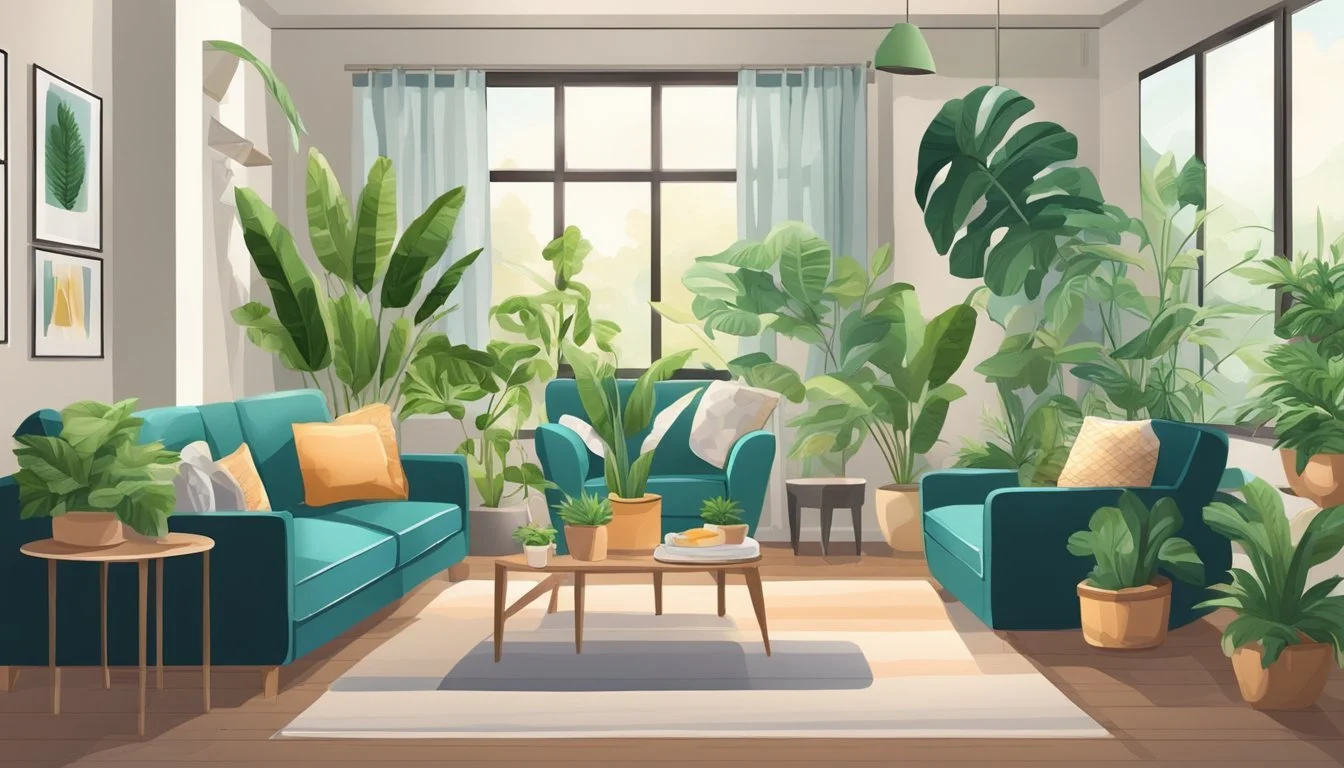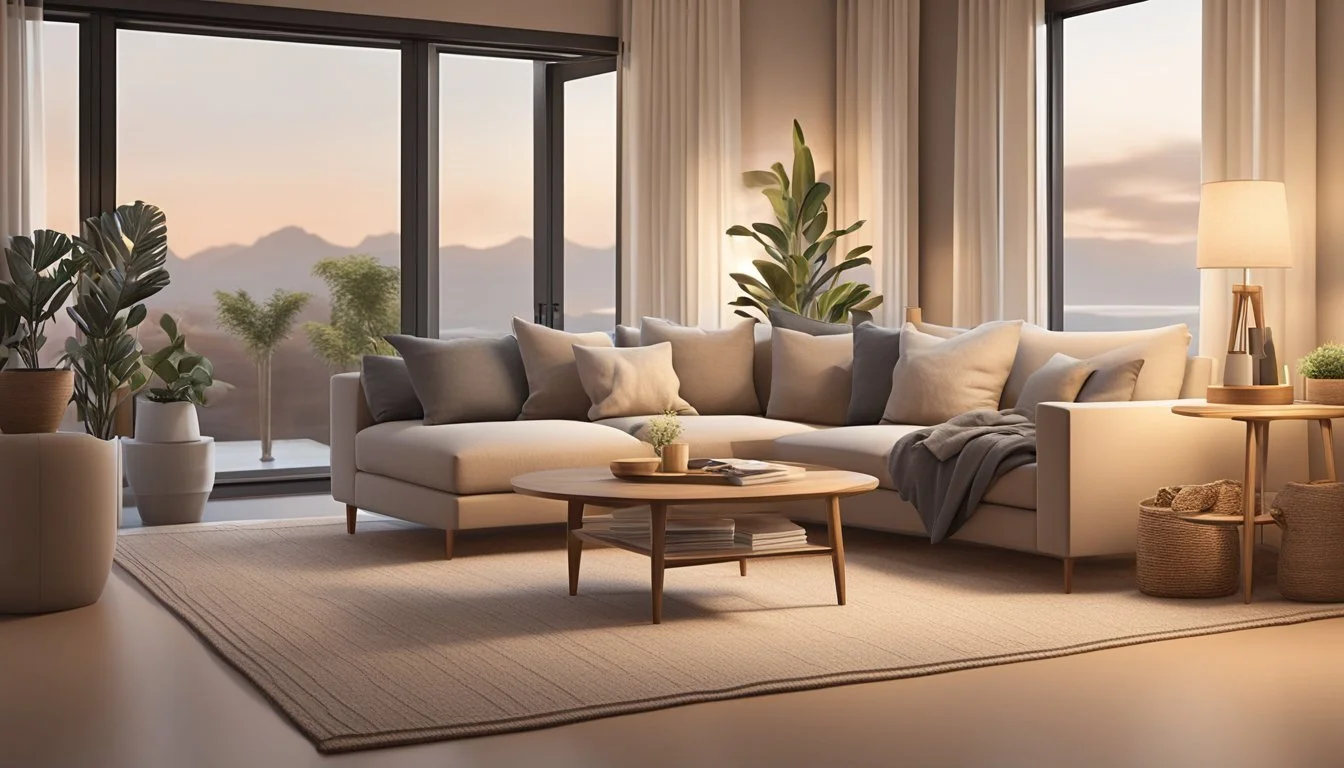11 HSP-Friendly Home Decor Ideas for Creating a Calming Sanctuary
Creating a comfortable living space is crucial for highly sensitive persons (HSPs) who are easily affected by their environment. HSPs often experience sensory overload from everyday stimuli, making it essential to design their homes thoughtfully. By implementing HSP-friendly decor ideas, individuals can transform their living spaces into calming sanctuaries that support their well-being and provide much-needed respite.
The following tips offer practical ways to adapt home decor for HSPs. These suggestions focus on reducing sensory input, creating soothing atmospheres, and promoting relaxation. By incorporating these ideas, HSPs can craft spaces that nurture their sensitive nature and enhance their daily lives.
1) Soft Area Rugs for Cozy Vibes
Soft area rugs can transform a space, creating a cozy and inviting atmosphere perfect for HSPs. These plush floor coverings provide comfort underfoot and help absorb sound, reducing sensory overload.
Shag rugs are an excellent choice for maximum softness. With their thick, luxurious pile, they offer a soothing tactile experience. Wool rugs are another great option, naturally soft and durable.
When selecting a rug, consider the pile height. High-pile rugs, typically 1 inch or more in thickness, offer the most cushioning and comfort. These work well in bedrooms and living areas where relaxation is key.
For those concerned about maintenance, some soft rugs are machine washable. This feature can be particularly appealing to HSPs who prefer easy-care options.
Color and pattern choices matter too. Neutral tones and subtle designs can create a calming effect, while bold patterns might be overstimulating for some HSPs. It's important to choose what feels right for individual sensitivities.
Placing soft rugs strategically throughout the home can create zones of comfort. They're especially beneficial in areas where one might spend time barefoot or seated on the floor.
2) Dimmer Switches for Adjustable Lighting
Dimmer switches offer highly sensitive individuals precise control over their lighting environment. These devices allow users to adjust the brightness of their lights to suit their comfort levels and needs throughout the day.
Many modern dimmer switches are compatible with LED, halogen, and incandescent bulbs. This versatility ensures they can be used with various lighting fixtures throughout the home.
Some popular dimmer switch options include the Lutron Diva LED+ and the Maxxima 3-way dimmer. These switches provide smooth dimming capabilities without flickering, which can be particularly beneficial for HSPs.
Smart dimmer switches like the Kasa Smart Dimmer HS220 offer additional features. They can be controlled remotely via smartphone apps or voice assistants, allowing for easy adjustments without having to physically interact with the switch.
When selecting a dimmer switch, it's important to consider the wattage rating. Choose a switch that can handle the total wattage of the connected lights with some extra capacity for safety.
Installing dimmer switches in key areas of the home, such as bedrooms, living rooms, and home offices, can create a more comfortable and adaptable environment for highly sensitive individuals.
3) Himalayan Salt Lamps for Calming Ambiance
Himalayan salt lamps can create a soothing atmosphere in any room. These lamps are crafted from pink salt crystals mined from the Himalayan mountains. When lit, they emit a warm, soft glow that many find calming.
The natural pink hue of the salt creates a gentle ambiance. This soft lighting can be particularly appealing to highly sensitive people who may find harsh lighting overwhelming.
Salt lamps come in various sizes, from small nightlights to large statement pieces. Smaller lamps work well in bedrooms or offices, while larger ones can serve as focal points in living areas.
Some believe these lamps have air-purifying properties, though scientific evidence is limited. Regardless, many people enjoy their aesthetic appeal and find them relaxing.
When choosing a salt lamp, look for ones made from 100% Himalayan salt to ensure authenticity. The size of the lamp can impact its effect, with larger lamps generally having a more noticeable presence.
Placing salt lamps strategically around the home can create pockets of calm. They can be especially effective in areas where relaxation is desired, such as reading nooks or meditation spaces.
4) Essential Oil Diffusers for Aromatherapy
Essential oil diffusers can create a soothing atmosphere for highly sensitive people (HSPs). These devices disperse aromatic oils into the air, potentially promoting relaxation and well-being.
Many diffusers offer customizable settings, allowing users to control mist intensity and duration. Some models feature ambient lighting options, enhancing the calming effect.
Popular essential oils for HSPs include lavender for relaxation, peppermint for focus, and eucalyptus for clearer breathing. It's important to choose high-quality, pure essential oils for the best results.
Ultrasonic diffusers are a common choice, using water and vibration to create a fine mist. They often have large water capacities, allowing for extended use without frequent refills.
When selecting a diffuser, consider factors like noise level, ease of cleaning, and design. Some diffusers double as decorative pieces, blending seamlessly with home decor.
For HSPs who travel, portable diffusers are available. These compact devices can help create a familiar, comforting environment away from home.
5) Soundproof Curtains for Noise Reduction
Soundproof curtains offer an effective solution for HSPs seeking to reduce external noise in their living spaces. These specialized curtains are designed with thick, dense materials that absorb sound waves, creating a quieter environment.
Many soundproof curtains feature multiple layers of fabric, including thermal insulation and blackout properties. This combination not only reduces noise but also blocks light and regulates room temperature.
Popular options like the MIUCO Room Darkening Curtains can filter out approximately 60% of outside noise. They also block up to 98% of sunlight and 100% of UV rays, providing additional benefits for light-sensitive individuals.
When selecting soundproof curtains, consider factors such as size, material, and style. Curtains with wider widths and longer lengths generally provide better coverage and noise reduction.
Some curtains, like the Nicetown high-end thermal curtains, feature a two-layer triple weave blackout fabric for enhanced soundproofing. Others, such as the Deconovo soundproof curtains, incorporate high-density materials specifically designed to eliminate noise.
By installing soundproof curtains, HSPs can create a more peaceful and comfortable home environment, reducing sensory overload and promoting relaxation.
6) Weighted Blankets for Deep Rest
Weighted blankets offer a comforting solution for highly sensitive people seeking deeper rest. These blankets typically range from 5 to 30 pounds, providing gentle pressure that can promote relaxation and better sleep.
The added weight mimics the sensation of a gentle hug, potentially reducing anxiety and promoting a sense of calm. Many users report feeling more grounded and secure when using these blankets.
Choosing the right weight is crucial for comfort and effectiveness. A general guideline is to select a blanket that's about 10% of the user's body weight. For children, lighter options between 4 and 10 pounds are available.
Materials vary, with options including cotton, bamboo rayon, and polyester. Some blankets use glass beads for weight, while others incorporate alternative fillings. The outer fabric can significantly impact comfort and temperature regulation.
Maintenance is an important consideration. Many weighted blankets are machine washable, though some may require special care. It's advisable to check the care instructions before purchasing.
For HSPs, weighted blankets can create a cozy, soothing environment that promotes relaxation and enhances sleep quality. They serve as a practical addition to a sensory-friendly home decor strategy.
7) Nature-Inspired Art Prints
Nature-inspired art prints offer a calming and visually appealing way to bring the outdoors inside. These prints can feature various natural elements like landscapes, plants, animals, or abstract representations of nature.
For highly sensitive people (HSPs), choosing the right art prints is crucial. Soft, muted colors and gentle scenes can create a soothing atmosphere. Watercolor paintings of flowers or serene forest landscapes often work well.
Consider selecting prints with calming blue tones, such as ocean scenes or sky views. These colors are known to promote relaxation and tranquility. Alternatively, green hues found in botanical prints can evoke a sense of growth and renewal.
Abstract nature prints can also be suitable for HSPs. These pieces often capture the essence of natural forms without overwhelming detail. Look for prints that use organic shapes and flowing lines.
When arranging nature prints, balance is key. Group similar themes together or create a gallery wall with complementary pieces. Ensure the overall effect is harmonious rather than cluttered or chaotic.
Remember to choose frames that complement the prints and your existing decor. Natural wood frames can enhance the organic feel of nature-inspired art.
8) Indoor Plants for Air Purification
Indoor plants can significantly improve air quality while adding natural beauty to your home. Several plant species are particularly effective at removing toxins and purifying the air.
The spider plant is a popular choice for its easy maintenance and ability to remove formaldehyde and xylene from the air. Its arching leaves with white stripes provide an elegant touch to any room.
Peace lilies are another excellent option. These glossy-leaved plants with white blooms absorb ammonia, formaldehyde, benzene, and trichloroethylene. They thrive in areas with poor ventilation, making them ideal for bathrooms or bedrooms.
The philodendron heartleaf is a fast-growing, low-maintenance plant that thrives in various light conditions. Its heart-shaped leaves not only purify the air but also add a lush, tropical feel to your space.
For those with limited space, the weeping fig (Ficus benjamina) is an excellent choice. Growing 3-6 feet tall indoors, it effectively purifies air in smaller rooms and doesn't require much light.
To maximize air purification benefits, it's recommended to incorporate multiple plants throughout your home. This creates a natural air-purifying system that continually improves indoor air quality.
9) Soy Candles with Gentle Scents
Soy candles offer a gentle and natural option for creating a soothing atmosphere in HSP-friendly spaces. These candles are made from renewable soybean wax, providing a cleaner burn compared to traditional paraffin alternatives.
Many soy candles feature subtle, calming scents that won't overwhelm sensitive individuals. Popular gentle fragrances include vanilla, lavender, and light citrus notes like mandarin or lime.
Essential oil-based scents are often used in soy candles, offering natural aromatherapy benefits. Some candles combine multiple mild scents, such as basil with citrus, for a balanced and refreshing aroma.
Soy wax typically burns longer than paraffin, allowing for extended enjoyment of the gentle fragrance. The natural ingredients also tend to produce less soot, maintaining better air quality in the home.
When selecting soy candles, look for options with cotton wicks and 100% natural soy wax for the purest experience. Many brands offer a variety of subtle scents, allowing HSPs to find the perfect match for their sensitivities and preferences.
10) Natural Fiber Throw Blankets
Natural fiber throw blankets offer comfort and style for highly sensitive people (HSPs). These blankets are made from materials like organic cotton, wool, and alpaca, which are gentle on the skin and free from harsh chemicals.
Eco-friendly options abound, with many companies using recycled fibers or sustainable production methods. For example, some blankets are made from 70% recycled wool and 30% mixed fibers, giving new life to preloved materials.
Fair Trade certified blankets ensure ethical production practices. Many are crafted by artisans in countries like India, Turkey, and Pakistan, supporting local communities while providing high-quality products.
Weighted blankets made from natural fibers can be particularly soothing for HSPs. Look for options filled with glass beads and covered in organic cotton for a chemical-free, comforting experience.
When choosing a natural fiber throw blanket, consider certifications like OEKO-TEX Standard 100, which guarantees the absence of harmful substances. This ensures a truly HSP-friendly addition to your home decor.
11) Mindful Wall Art: 'Breathe' - Author Unknown
Simple yet powerful, a 'Breathe' wall art piece can transform any room into a calming sanctuary. This type of mindful decor serves as a gentle reminder for Highly Sensitive Persons to pause and reconnect with their breath.
The word 'Breathe' displayed prominently in a serene font can help HSPs center themselves during moments of overwhelm. It acts as a visual cue to take a moment for self-care and mindfulness.
Many variations of 'Breathe' wall art are available, from minimalist prints to more ornate designs. Some incorporate calming colors like soft blues or greens, while others feature nature-inspired elements such as leaves or waves.
For HSPs who appreciate simplicity, a black and white 'Breathe' print can provide a soothing focal point without overstimulating the senses. Those who prefer a touch of personalization might opt for a customizable piece with additional meaningful words or symbols.
Placing this mindful wall art in frequently visited areas of the home, such as the bedroom or living room, can offer regular opportunities for moments of calm. It serves as a constant, gentle nudge towards mindfulness in daily life.
Understanding HSP Needs in Home Decor
Highly Sensitive People require thoughtful design choices to create a harmonious living space. Key considerations include minimizing sensory overload and incorporating elements that promote calm and relaxation.
Creating a Calming Environment
HSPs benefit from a light and reduced furnishing approach. Decluttering helps manage visual stimuli and creates a sense of spaciousness. Soft, muted color palettes promote tranquility. Natural materials like wood and stone can add warmth without overwhelming the senses.
Lighting plays a crucial role. Opt for adjustable, warm-toned lighting options to control brightness levels. Blackout curtains or blinds allow for complete darkness when needed. Incorporating nature elements, such as plants or nature-inspired artwork, can enhance the calming atmosphere.
Sensory Sensitivities and Decor Choices
Texture selection is vital for HSPs. Choose soft, comfortable fabrics for upholstery and bedding. Avoid scratchy or rough materials that may cause discomfort. Consider using noise-reducing materials like thick curtains or carpets to minimize external sounds.
Scent can significantly impact an HSP's well-being. Use essential oil diffusers with calming fragrances like lavender or chamomile. Be mindful of strong-smelling cleaning products or air fresheners that may overwhelm sensitive noses.
Temperature regulation is important. Install programmable thermostats for consistent comfort. Use breathable bedding materials to prevent overheating during sleep.
Colors and Lighting for HSPs
Creating a soothing environment through thoughtful color choices and appropriate lighting can significantly impact an HSP's well-being at home. These elements play a crucial role in setting the mood and reducing sensory overload.
Soothing Color Palettes
HSPs often benefit from soft, muted colors that create a calm atmosphere. Pale blues, gentle greens, and warm neutrals like beige and light gray are excellent choices for walls and large furniture pieces. These colors can help reduce visual stimulation and promote relaxation.
Avoid using bright, bold colors in large areas, as they may overwhelm sensitive individuals. Instead, incorporate pops of color through small accents like throw pillows or artwork. This allows for personalization without compromising the overall tranquil ambiance.
Consider using a monochromatic color scheme, which can create a sense of harmony and cohesion in a space. Varying shades of a single color can add depth and interest without being visually jarring.
Natural vs Artificial Lighting
Natural light is generally preferable for HSPs, as it can help regulate circadian rhythms and improve mood. Large windows with adjustable blinds or sheer curtains allow for control over light intensity throughout the day.
When artificial lighting is necessary, opt for warm, dimmable LED bulbs that mimic natural light. Avoid harsh fluorescent lighting, which can cause eye strain and headaches in sensitive individuals.
Layer lighting sources to create a flexible environment. Use a combination of ambient, task, and accent lighting to adjust the atmosphere as needed. Soft, indirect lighting from floor lamps or wall sconces can provide a gentle glow without being too intense.
Consider installing light filters or blue light-blocking options on electronic devices to reduce eye strain during evening hours. This can help promote better sleep patterns for HSPs.
Incorporating Nature in Home Decor
Bringing natural elements into your living space creates a calming atmosphere and connects you with the outdoors. This approach benefits highly sensitive people by reducing stress and promoting wellbeing.
Benefits of Indoor Plants
Indoor plants purify the air by removing toxins and releasing oxygen. They improve humidity levels, which can help with respiratory issues and dry skin. Caring for plants provides a gentle, nurturing routine that can be soothing for HSPs.
Popular low-maintenance options include snake plants, pothos, and ZZ plants. These thrive in various light conditions and don't require frequent watering. For a bolder statement, consider a fiddle leaf fig or monstera deliciosa.
Place plants strategically to maximize their impact. Group them in corners, use hanging planters, or create a green wall for a dramatic effect. Remember to choose non-toxic varieties if you have pets.
Using Natural Materials
Incorporating natural materials adds texture and warmth to your home. Wood, stone, and woven fibers create a grounding effect that resonates with HSPs' need for comfort and authenticity.
Choose furniture with wooden elements or exposed grain. Opt for stone countertops or decorative pieces. Incorporate woven baskets, jute rugs, or rattan chairs to add organic textures.
Natural fabrics like cotton, linen, and wool feel soft against the skin and regulate temperature well. Use these for bedding, curtains, and upholstery to create a cozy, breathable environment.
Bring in elements from nature itself. Display a collection of smooth river rocks, arrange dried flowers, or showcase interesting driftwood pieces as artistic focal points.











